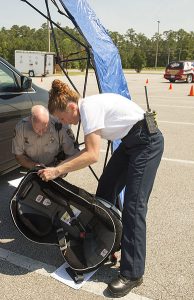 Beginning on January 1, 2017, residents of San Diego County will have to abide by a new law concerning child injury prevention and auto accident safety. According to a recent article in the Benito Link, as of the first of the year—just a few months away now—California residents will have to pay close attention to a new law that requires children who are under the age of 2 to ride in a rear-facing car seat. There are only a couple of exceptions to the recently passed law. If the child weighs 40 pounds or more, or if the child is 40 inches tall or greater, then the child is not subject to the terms of the new law, even if she or he is under the age of 2.
Beginning on January 1, 2017, residents of San Diego County will have to abide by a new law concerning child injury prevention and auto accident safety. According to a recent article in the Benito Link, as of the first of the year—just a few months away now—California residents will have to pay close attention to a new law that requires children who are under the age of 2 to ride in a rear-facing car seat. There are only a couple of exceptions to the recently passed law. If the child weighs 40 pounds or more, or if the child is 40 inches tall or greater, then the child is not subject to the terms of the new law, even if she or he is under the age of 2.
What else should you know about this law? And will it help to prevent child injuries in serious car accidents?
Comparing California’s Car Seat Laws and Child Seat Safety
In addition to the age requirement specified by the new law, there is another part of the law that parents should understand. Regardless of whether your child is required by law to ride in a rear-facing seat—those under the age of 2 regardless of the child’s weight and/or height—there are additional requirements: the child also must be “secured in a manner that complies with the height and weight limits specified by the manufacturer of the car seat,” according to a fact sheet from the California Highway Patrol (CHP). As such, parents will need to pay particular attention to the safety requirements provided by the car seat manufacturer.
How does the new law compare to the one that is currently in effect? As the CHP fact sheet explains, current California law requires children who are under the age of 8 to be secured in a car seat or a booster seat, and they must be in the back seat of the automobile, unless they have reached the height of 4’9”. For children between the ages of 8 and 15, as well as those under the age of 8 who are 4’9” or taller, still must sit in the back seat and be secured with a safety belt. For passengers who are at least 16 years old, standard safety laws—including California’s Mandatory Seat Belt law—are applicable.
As you can see, current law does not address safety requirements aimed specifically at younger children, including infants and toddlers.
Ensuring that You Comply with California Law on Child Safety Seats
How can you be certain that you are complying with the law? In addition to ensuring that your toddler or infant is secured in a rear-facing car seat in the back, it may be difficult to ascertain, with certainty, whether you are also abiding by the manufacturer’s safety instructions. As the article in Benito Link highlights, the CHP is co-hosting a number of child safety seat events with organizations such as AAA Insurance and Safe Kids California.
In a parking lot near you, you may be able to meet with a CHP officer who can perform a “Car seat safety check-up” for you to ensure that you are abiding by the new law that will go into effect in January.
In the meantime, if your child got hurt in a car accident, you may be able to file a claim for compensation. An experienced San Diego car accident attorney can help. Contact the Walton Law Firm today for more information.
See Related Blog Posts:
 North County San Diego Injury Lawyers
North County San Diego Injury Lawyers








